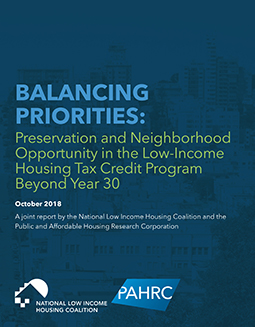NLIHC and PAHRC Issue New Report on ‘Year 30’ and on Balancing Preservation and Mobility in the Tax Credit Program
Oct 22, 2018
 NLIHC and the Public and Affordable Housing Research Corporation (PAHRC) released a new report on October 17 titled Balancing Priorities: Preservation and Neighborhood Opportunity in the Low Income Housing Tax Credit Program Beyond Year 30. The report sheds light on preservation challenges with an examination of the neighborhood characteristics of LIHTC units reaching the end of their affordability and income restrictions and a discussion of how scarce resources for affordable housing lead to the dilemma between prioritizing the preservation of affordable housing versus promoting mobility for low income families to access higher-opportunity neighborhoods. The report addresses this dilemma by offering a broader vision for a housing safety net.
NLIHC and the Public and Affordable Housing Research Corporation (PAHRC) released a new report on October 17 titled Balancing Priorities: Preservation and Neighborhood Opportunity in the Low Income Housing Tax Credit Program Beyond Year 30. The report sheds light on preservation challenges with an examination of the neighborhood characteristics of LIHTC units reaching the end of their affordability and income restrictions and a discussion of how scarce resources for affordable housing lead to the dilemma between prioritizing the preservation of affordable housing versus promoting mobility for low income families to access higher-opportunity neighborhoods. The report addresses this dilemma by offering a broader vision for a housing safety net.
The Low Income Housing Tax Credit (LIHTC) has financed the construction, rehabilitation, or preservation of approximately three million rental housing units affordable to low-income households since its inception in 1987, making it the largest national affordable housing program in the U.S. With some limited exceptions, federal law requires existing LIHTC housing to remain affordable for a minimum of 30 years, with some states extending the affordability period beyond that. As the LIHTC program ages, the risk of current LIHTC units being lost from the affordable housing stock grows. By 2030, nearly half a million current LIHTC units, or nearly a quarter of the total stock, will reach their 30-year mark and the end of their federally mandated affordability restrictions. Without new capital investment for rehabilitation and renovation, many of these units are also at-risk of physical deterioration.
The report finds nearly 200,000 (42%) units reaching Year 30 are particularly at-risk for physical deterioration because they are in the least desirable neighborhoods where rental income to address capital needs is likely limited, while nearly 17,000 (4%) units with for-profit owners in highly desirable neighborhoods are particularly at-risk of converting to higher-cost, private-market housing.
The report argues that scarce resources for preservation and new production will necessitate difficult decisions between preserving the existing LIHTC stock, much of which is in lower opportunity neighborhoods, versus preserving and expanding the stock in higher opportunity neighborhoods. To address this dilemma, the report advocates for a broader housing safety net based on a fully funded Housing Choice Voucher program with expanded production subsidies targeted to where they are most needed.
Balancing Priorities: Preservation and Neighborhood Opportunity in the Low Income Housing Tax Credit Program Beyond Year 30 is available at: https://bit.ly/2pVyXcD